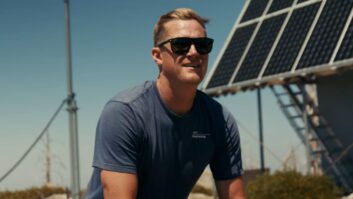MIDDELKERKE, Belgium — For the 6th edition of the “Nostalgie Beach Festival,” commercial radio station Nostalgie Vlaanderen installed an on-air studio next to the festival stage, boosting its visibility and guaranteeing proximity to the audience.

Over 15,000 people attended the annual event that took place on August 10. With bands like Wet, Wet Wet, Fischer Z , Flemish top band Clouseau and Status Quo performing, the festival’s line-up perfectly matched Nostalgie’s on-air format.
For the station’s live broadcasts, between 10:00 a.m. and midnight, Nostalgie made use of a split Lawo Ruby AoIP mixing console for the first time. The system mixed the microphone and live sources, providing full remote control of the broadcaster’s Lawo Ruby located in its main on-air studio in Antwerp.

TECHNICAL CONFIGURATION
“The twin Lawo Ruby set-up allowed us to define remotely controllable channels,” said Tom Callebaut of Radiostudio.be , who provided the technical set-up in Middelkerke. “We established a secure VPN tunnel from the beach to our main studio to ensure a glitch-free and secure connection between both Lawo Ruby consoles. The remote control ran on the EmBER+ protocol allowing us fader-start and level-control of the Zenon-playout solution in Antwerp. We established the screens and human interaction on the playout system by using the Teamviewer software.”

Luk De Groote, technical manager for Nostalgie Vlaanderen said they developed the set-up in close collaboration with Radiostudio.be. “The system was first used and tested during NRJ België’s morning broadcast when we aired from a yacht in the Antwerp port,” De Groote explained. “We further elaborated the configuration in view of the live broadcast at the Beach Festival.”
Callebaut added that the festival’s technical layout was nearly identical to that of the main studio. “We used two Telos AoIP Zip One codecs to link the audio from both studios. One channeled the audio from the presenter, audience and artists’ interviews from the remote studio. The second one returned the audio signal that was played out in Antwerp. This offered the hosts a “normal studio experience” one they are used to,” he said.
[Read: Belgium’s Wallonia-Brussels Federation Redefines Radio Landscape]
“Thanks to the EmBER+ link, our engineer Jan Hodister in Antwerp was able to see all the fader movements, made on the beachside on-air console. When and if necessary, he could adjust the faders as well, immediately visible on the board in Middelkerke, as the link was in full duplex,” he said. STATION VISIBILITY

Zenon’s files were played from the main studio in Antwerp. “The big advantage of this remote-approach is that the played audio is not coming from the remote studio – without any audible effect on the broadcast. In case of an interference, the engineer in Antwerp takes over. With the audio already coming from the Antwerp studio, the listeners won’t notice any problem on the air. We’ve anticipated this in case of a connection drop,” explained Callebaut. “While the connection is being re-established, the radio show continues from our Antwerp studio so the engineers can investigate and work on the problem.”
In addition to the station’s musical program and interviews, Nostalgie Vlaanderen also broadcast live snippets from the festival’s stage. “We get a live mix from the FOH console — every recording is checked by the artists’ managements for clearance. The authorized .WAV files are then used during the live broadcast, offering live footage from most bands that played on the festival,” added De Groote.
For Tom Klerkx, managing director of Nostalgie Vlaanderen, the station’s visibility was a crucial element throughout the one-day festival.
“At most other festivals, participating radio stations are not very visible. This year, we were close to the stage and the audience was able to see the presenters and the radio studio. We invited listeners to the panoramic studio as well,” he added.







